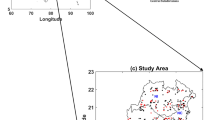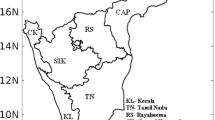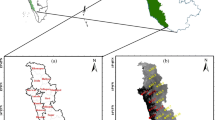Abstract
In this study, analysis of the long term climatology, variability and trends in the daily rainfall events of ≥5 mm [or daily rainfall (DR) events] during the southwest monsoon season (June–September) over four regions of India; south central India (SCI), north central India (NCI), northeast India (NEI) and west coast (WC) have been presented. For this purpose, a new high spatial resolution (0.25° × 0.25°) daily gridded rainfall data set covering 110 years (1901–2010) over the Indian main land has been used. The association of monsoon low pressure systems (LPSs) with the DR events of various intensities has also been examined. Major portion of the rainfall over these regions during the season was received in the form of medium rainfall (≥5–100 mm) or moderate rainfall (MR) events. The mean seasonal cycle of the daily frequency of heavy rainfall (HR) (≥100–150 mm) or HR events and very heavy rainfall (VHR) (≥150 mm) or VHR events over each of the four regions showed peak at different parts of the season. The peak in the mean daily HR and VHR events occurred during middle of July to middle of August over SCI, during late part of June to early part of July over NCI, during middle of June to early July over NEI, and during late June to middle July over WC. Significant long term trends in the frequency and intensity of the DR events were observed in all the four geographical regions. Whereas the intensity of the DR events over all the four regions showed significant positive trends during the second half and the total period, the signs and magnitude of the long term trends in the frequency of the various categories of DR events during the total period and its two halves differed from the region to the region. The trend analysis revealed increased disaster potential for instant flooding over SCI and NCI during the recent years due to significant increasing trends in the frequency (areal coverage) and intensity of the HR and VHR events during the recent half of the data period. However, there is increased disaster potential over NEI and WC due to the increasing trends in the intensity of the rainfall events. There is strong association between the LPS days and the DR events in both the spatial and temporal scales. In all the four regions, the contributions to the total MR events by the LPS days were nearly equal. On the other hand, there was relatively large regional difference in the number of combined HR and VHR events associated with LPS days particularly that associated with monsoon depression (LPS stronger than monsoon depression) days. The possible reasons for the same have also been discussed. The increasing trend in the monsoon low (low pressure) days post 1970s is the primary reason for the observed significant increasing trends in the HR and VHR events over SCI and NCI and decreasing trend in HR events over NEI during the recent half (1956–2010). This is in spite of the decreasing trend in the MD days.











Similar content being viewed by others
References
Ajayamohan RS, Merryfield William J, Kharin Viatcheslav V (2010) Increasing trend of synoptic activity and its relationship with extreme rain events over central India. J Clim 23:1004–1013
Alexander G, Keshavamurty RN, De US, Chellappa R, Das SK, Pillai PV (1978) Fluctuations of monsoon activity. Indian J Meteor Geophys 29:76–87
Francis PA, Gadgil Sulochana (2006) Intense rainfall events over the west coast of India. Meteorol Atmos Phys 94(1–4):27–42
Ghosh S, Luniya V, Gupta A (2009) Trend analysis of Indian summer monsoon rainfall at different spatial scales. Atmos Sci Lett 10:285–290
Goswami BN, Venugopal V, Sengupta D, Madhusoodanan MS, Xavier PK (2006) Increasing trend of extreme rain events over India in a warming environment. Science 314:1442–1445
Goswami BB, Mukhopadhyay P, Mahanta R, Goswami BN (2010) Multiscale interaction with topography and extreme rainfall events in the northeast Indian region. J Geophys Res 115:D12114. doi:10.1029/2009JD012275
Guhathakurta P, Shreejith OP, Menon PA (2011) Impact of climate change on extreme rainfall events and flood risk in India. J Earth Syst Sci 120(3):359–373
IPCC (2013) Summary for policymakers. In: Stocker TF, Qin D, Plattner G-K, Tignor M, Allen SK, Boschung J, Nauels A, Xia Y, Bex V, Midgley PM (eds) Climate Change (2013) The physical science basis. Contribution of working group I to the fifth assessment report of the IPCC. Cambridge University Press, Cambridge
Jadhav SK (2002) Summer monsoon low pressure systems over the Indian region and their relationship with the sub-divisional rainfall. Mausam 53:177–186
Joshi U, Rajeevan M (2006) Trends in precipitation extremes over India, NCC RR No. 3, National Climate Centre, IMD Pune, India, 25 pp
Krishnamurthy CKB, Lall U, Kwon HH (2009) Changing frequency and intensity of rainfall extremes over India from 1951 to 2003. J Clim 22:4737–4746
Krishnamurthy V, Ajayamohan RS (2010) Composite structure of monsoon low pressure systems and its relation to Indian rainfall. J Clim 23:4285–4305
Krishnamurti TN, Bhalme HN (1976) Oscillations of a monsoon system part 1. Observational aspects. J Atmos Sci 33:1937–1954
Mooley DA, Shukla J (1989) Main features of the westward-moving low pressure systems which form over the Indian region during the summer monsoon season and their relation to the monsoon rainfall. Mausam 40:137–152
Pai DS, Sridhar Latha, Rajeevan M, Sreejith OP, Satbhai NS, Mukhopadhyay B (2014) Development of a new high spatial resolution (0.25° × 0.25°) long period (1901–2010) daily gridded rainfall data set over India and its comparison with existing data sets over the region. Mausam 65(1):1–18
Raghavan K (1973) Break monsoon over India. Mon Weather Rev 101:33–43
Rajeevan M, Bhate J (2009) A high resolution daily gridded rainfall data set (1971–2005) for mesoscale meteorological studies. Curr Sci 96(4):558–562
Rajeevan M, Bhate J, Kale JD, Lal B (2006) High resolution daily gridded rainfall data for the Indian region: analysis of break and active monsoon spells. Curr Sci 91(3):296–306
Rajeevan M, Bhate J, Jaswal AK (2008) Analysis of variability and trends of extreme rainfall events over India using 104 years of gridded daily rainfall data. Geophys Res Lett 35:L18707. doi:10.1029/2008GL035143
Rajeevan M, Gadgil Sulochana, Bhate Jyoti (2010) Active and break spells of the Indian summer monsoon. J Earth Syst Sci 119(3):229–247
Ramamurthy K (1969) Monsoon of India: some aspects of the ‘break’ in the Indian southwest monsoon during July and August. Forecasting Manual 1-57 No. IV 18.3, India Met. Dept., Pune, India
Sen Roy S, Balling RC Jr (2004) Trends in extreme daily precipitation indices in India. J Clim 24(4):457–466
Sikka D (1980) Some aspects of the large scale fluctuations of summer monsoon rainfall over India in relation to fluctuations in the planetary and regional scale circulation parameters. Proc Indian Acad Sci Earth Planet Sci 89:179–195
Trenberth KE (2011) Changes in precipitation with climate change. Clim Res 47:123–138. doi:10.3354/cr00953
Yatagai A, Kamiguchi K, Arakawa O, Hamada A, Yasutomi N, Kitoh A (2012) APHRODITE: constructing a long-term daily gridded precipitation dataset for Asia based on a dense network of rain gauges. Bull Am Meteorol Soc 93:1401–1415
Acknowledgments
We would like to thank the anonymous reviewers for their valuable comments and suggestions to improve the quality of the paper. We are thankful to Dr. L. S. Rathore, DGM and Mr. B. Mukhopadhyay, ADGM (Research) for their encouragement and support in carrying out this study. We thank officers and staff of National Data Center (NDC) and Hydrology Section for their help in the scrutiny and various other issues related to the basic rain gauge data used in this study. We also appreciate support provided by our colleagues in the National Climate Center and Long Range Forecasting Division during various stages of the data analysis.
Author information
Authors and Affiliations
Corresponding author
Rights and permissions
About this article
Cite this article
Pai, D.S., Sridhar, L., Badwaik, M.R. et al. Analysis of the daily rainfall events over India using a new long period (1901–2010) high resolution (0.25° × 0.25°) gridded rainfall data set. Clim Dyn 45, 755–776 (2015). https://doi.org/10.1007/s00382-014-2307-1
Received:
Accepted:
Published:
Issue Date:
DOI: https://doi.org/10.1007/s00382-014-2307-1




